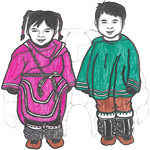Children's Book Collection
These books form a collection of 32 Inuktitut language books created by Inuit educators from Nunavik childcare centres who participated in training workshops held in Kuujjuaq, Kuujjuarapik, Puvirnituq or Quaqtaq between December 2014 and February 2016.
Activities
Games without toys
Here are some ideas of games you can play with children. No toys needed!
0-12 months
- Rhythm Game:
move the baby in your arms while singing, telling nursery rhymes or dancing. - Bicycling:
while changing the diaper, move the baby’s legs as if he was bicycling. - Funny Clown:
make funny faces, blink your eyes, blow up your cheeks, do the sound of an engine. - Peek-a-Boo:
hide your face behind your hands, a blanket, a facecloth. Babies love that game. - The Voice Magician:
change your voice to a high pitch or a very low voice like Santa Clause. - The Surprising Singer:
sing a song using different pace (slow, fast) and volume (loud, soft). - The Horsy:
sit on a chair and place the child on your lap. Hold him under the armpits (or by the hands if he is strong enough) and bounce your legs up and down. Do the horse sounds. Again, you can go fast or slow.
12-24 months
- I’m Gonna Catch You!:
on your 4 legs, chase the children. They will love you being at their eye-level. Once you catch them, give kisses and hugs. - Moo! Moo!:
do the sounds of animals. Great for car rides or stroller rides. - The Storm on the Water:
lie down on your back, fold your legs and sit the child on your knees holding his hands. As the storm is coming, move your legs so the child has to keep his balance. - The Bell:
Stand up and hold the child by the armpits. Swing him back and forth and say: Ding! Dong! - The Talking Face:
do different facial expressions (angry, happy, sad, afraid, tired, surprised, etc.) Ask the child to guess the feeling. Switch turns. Children will learn they can communicate even if they don’t have words.
2-3 years old
- Hide-and-Seek:
a classic! - Nursery Rhymes:
Kids love those and never get tired of it. They can repeat them forever. Do gestures and have children create new ones. - The Telephone Line:
Quickly whisper a sentence to one child. He then does the same to another child. At the end, the last child to get the message says it out loud. It is always a totally different message. - The Mirror:
2 children facing each other. One does a something and the other has to do the same. Ex: put a hand on the head, stand on one leg, make a funny face, etc.
4 years and over
- The Crazy Kitchen:
imagine uncommon meals. Ex: French fries pie, ice-cream soup, carrot hot-dog, etc. - Memory Line:
quand je vais au marché, je mets dans mon p’tit panier….
[Source: Bien Grandir, Novembre 2011]
Resources
Special Activities and Schedules
Coming soon...













































